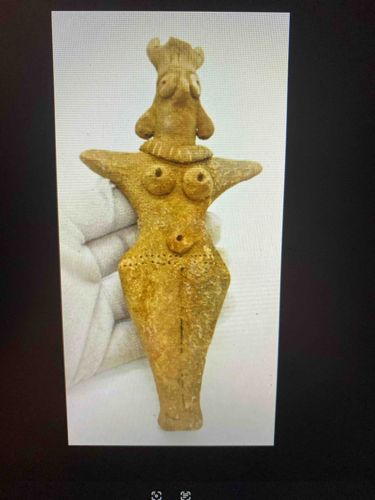
Syro-Hittite Terracotta Fertility Goddess Worshipper Figure
This item is a Syro-Hittite terracotta fertility goddess figure, also described as a worshipper, dating from approximately 1180 to 700 BCE. The figurine is 7.5 inches tall and crafted from unglazed, yellowish-tan terracotta clay. Its construction is primarily hand-modeled, showing clear signs of rudimentary yet deliberate shaping, characteristic of ancient folk art. The figure features an exaggerated female form, typical of fertility goddesses, with a prominent, almost conical head topped with what appears to be a headdress or intricate coiffure, possibly depicted with three distinct points or protrusions. The face is highly stylized, presenting with large, bulging eyes and a simplified, bird-like or beak-like nose area, lacking distinct mouth or ear features. A ridged or banded neck adornment is visible, separating the head from the torso. The torso is robust, with clearly articulated, perforated breasts, suggesting a method for attachment of ornamentation or simply a stylistic representation of nipples. Below the breasts, a single, central perforation is present, likely representing the navel. A band of incised dots or small impressions adorns the lower abdomen/pelvic region, possibly indicating pubic hair, a belt, or decorative textile. The arms are extended outwards in a 'T' shape, short and stubby, lacking detailed hands or fingers, suggesting an abstract or symbolic posture. The lower body tapers strongly into a cylindrical or conical base, lacking distinct legs or feet, which indicates it was likely meant to stand upright on a flat surface or be placed within an altar. The overall condition shows considerable wear and earth encrustations, consistent with its age and material, though no major breaks or repairs are immediately evident. The surface exhibits a natural patina acquired over millennia, adding to its archaeological authenticity. The craftsmanship, while not refined by modern standards, demonstrates the ancient artisan's skill in conveying symbolic meaning through form. The unglazed finish and hand-built nature are clear indicators of its ancient origin and traditional manufacturing methods.
AI-Generated Appraisal Disclaimer
Estimated Value
$3,000 - $5,000
Basic Information
Category
Ancient Terracotta Figurines
Appraised On
November 30, 2025
Estimated Value
$3,000 - $5,000
Additional Details Provided By Owner
User Provided Information
1180 to 700 BCE Syro-Hittite terracotta fertility goddess figure worshiper. 7.5” tall
Item Description
This item is a Syro-Hittite terracotta fertility goddess figure, also described as a worshipper, dating from approximately 1180 to 700 BCE. The figurine is 7.5 inches tall and crafted from unglazed, yellowish-tan terracotta clay. Its construction is primarily hand-modeled, showing clear signs of rudimentary yet deliberate shaping, characteristic of ancient folk art. The figure features an exaggerated female form, typical of fertility goddesses, with a prominent, almost conical head topped with what appears to be a headdress or intricate coiffure, possibly depicted with three distinct points or protrusions. The face is highly stylized, presenting with large, bulging eyes and a simplified, bird-like or beak-like nose area, lacking distinct mouth or ear features. A ridged or banded neck adornment is visible, separating the head from the torso. The torso is robust, with clearly articulated, perforated breasts, suggesting a method for attachment of ornamentation or simply a stylistic representation of nipples. Below the breasts, a single, central perforation is present, likely representing the navel. A band of incised dots or small impressions adorns the lower abdomen/pelvic region, possibly indicating pubic hair, a belt, or decorative textile. The arms are extended outwards in a 'T' shape, short and stubby, lacking detailed hands or fingers, suggesting an abstract or symbolic posture. The lower body tapers strongly into a cylindrical or conical base, lacking distinct legs or feet, which indicates it was likely meant to stand upright on a flat surface or be placed within an altar. The overall condition shows considerable wear and earth encrustations, consistent with its age and material, though no major breaks or repairs are immediately evident. The surface exhibits a natural patina acquired over millennia, adding to its archaeological authenticity. The craftsmanship, while not refined by modern standards, demonstrates the ancient artisan's skill in conveying symbolic meaning through form. The unglazed finish and hand-built nature are clear indicators of its ancient origin and traditional manufacturing methods.
Related Tags
Get Your Items Appraised
Instant estimates of your treasures with AI-powered instant appraisals